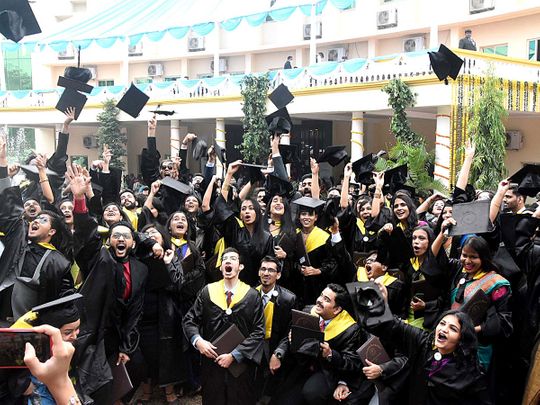
The dream of Indian students to study in India but get an international degree from a prestigious foreign university, to study abroad during the course of an Indian degree, or even get a dual degree, one from the home institution and the other one from a foreign university—all these, which would have seemed like flights of fancy in the past, are now close to become realities.
Thanks to the Indian University Grants Commission's notification of May 2 on new regulations on Academic Collaboration between Indian and Foreign Higher Educational Institutions, Indian higher education is about to open to foreign to partnerships with foreign universities as never before.
Under this notification, three possibilities are offered for collaboration between Indian and foreign universities. First, the “Twinning Programme,” under which an Indian institution may have a partner university abroad where its students can study for up to 30% of their degree requirements. The degree will be awarded by the Indian university.
This translates into a sort of study abroad programme, with the foreign host university and the home institution providing transcripts of their own respective course components and credits. The entire programme will be in conventional mode, that is through physical attendance at the foreign university for the credits earned there.
Joint Degree Programme
The second possibility is the “Joint Degree Programme.” Here, both the Indian and the foreign university will jointly develop curricula for degree, that will be awarded by a single certificate issued by both institutions upon the completion of the course.
Again, at least 30% of the course work and credits required for the degree must be earned at either of the two institutions through actual attendance, that is, in the conventional mode. Foreign universities, which want to save money in infrastructure and faculty, might opt for 70% of their curriculum delivery out of India, with a partner institution whose quality of instruction they might trust.
Both institutions stand to benefit from such a partnership, with Indian students getting a foreign degree, at least in principle, for 30% of the actual costs of actually studying abroad.
“Dual Degree Programme,” is the third scheme, opened up by the UGC. This would be jointly designed and offered by both institutions, Indian and foreign, in similar areas, with two separate degrees being offered on the completion of the requirements of both programmes. Students would have to be admitted to two programmes in effect, completing two admission processes and course requirements.
During the duration of studies, at least 30% of credits must be acquired from the Indian university through the conventional or in person mode of attending classes. For dual PhD degrees, there would be two supervisions, one from the Indian and another from the foreign university.
The two programmes might have a common component too. For example, suppose an Indian engineering college wants to team up with a foreign university to offer a BTech-MS programme in biosciences, it is obvious that a certain number of courses might be common to both programmes, but each degree would require another portion of course work to complete its requirements.
Dual degree programme
Students enrolled in the dual degree programme would save the time and the effort in the common component, but would still need to complete the remaining requirements to get both degrees.
In response to the notification, it was reported that close to 50 foreign universities have already expressed their interest in exploring the possibilities of collaboration with Indian universities and institutions. These include University of Glasgow, Scotland, University of Manchester, and School of African and Oriental Studies (SOAS), London, from the United Kingdom, Deakin University and University of Queensland, Australia, University of Tokyo, Durban University of Technology, South Africa, Universität Jena, Germany, and even Stanford and Massachusetts Institute of Technology (MIT), US.
According to Professor M Jagadeesh Kumar, Chairman, UGC, many foreign universities are interested in recruiting the best of Indian students for their PhD programmes, for which setting up shop in India or offering joint degrees is an attractive proposition.
From the Indian side too, several universities have already initiated steps to encourage such collaborations. Punjab University, Chandigarh, for example has asked each of its departments to identify two foreign universities with whom it would like to collaborate.
But in “the best laid schemes o' mice an' men” the devil is in the details. The fine print specifies that only the top 1000 universities according to QS or Times Higher Education rankings would be eligible for such collaboration. But other than that, the architecture seems quite open at the moment.
Scope of collaborations
The UGC’s 2016 rules on foreign collaborations, which the present notification supersedes, and even earlier ones going back to 2012, did not produce the desired results because of a hugely complicated regulatory mechanism. Also, the scope of collaborations was much more limited, without the opportunity of dual or joint degrees.
The present scheme is attractive in that it seems to leave the actual details to the partner institutions. Indian universities wishing to collaborate with foreign institutions would have to set up an office of international education to regulate the programmes, but after that the actual MoU between the two institutions would specify the rules and procedures governing each of these collaborations.
As long as they do not violate UGC regulations and criteria to be updated from time to time, they should be allowed to run on their own.
The smarter among the Indian schools will try to be first off the block to offer the most attractive study abroad twinning, joint, and dual degrees to their students.
Many universities from abroad, some better regarded than their Indian counterparts, others from the so-called Global South or less developed parts of the world will seek collaborations from Indian partners, depending on their own regulatory frameworks.
The possibilities are immense but one thing is certain: Indian higher education is poised for a fundamental change and makeover. Such a prospect, which has been long overdue, should be welcomed.





